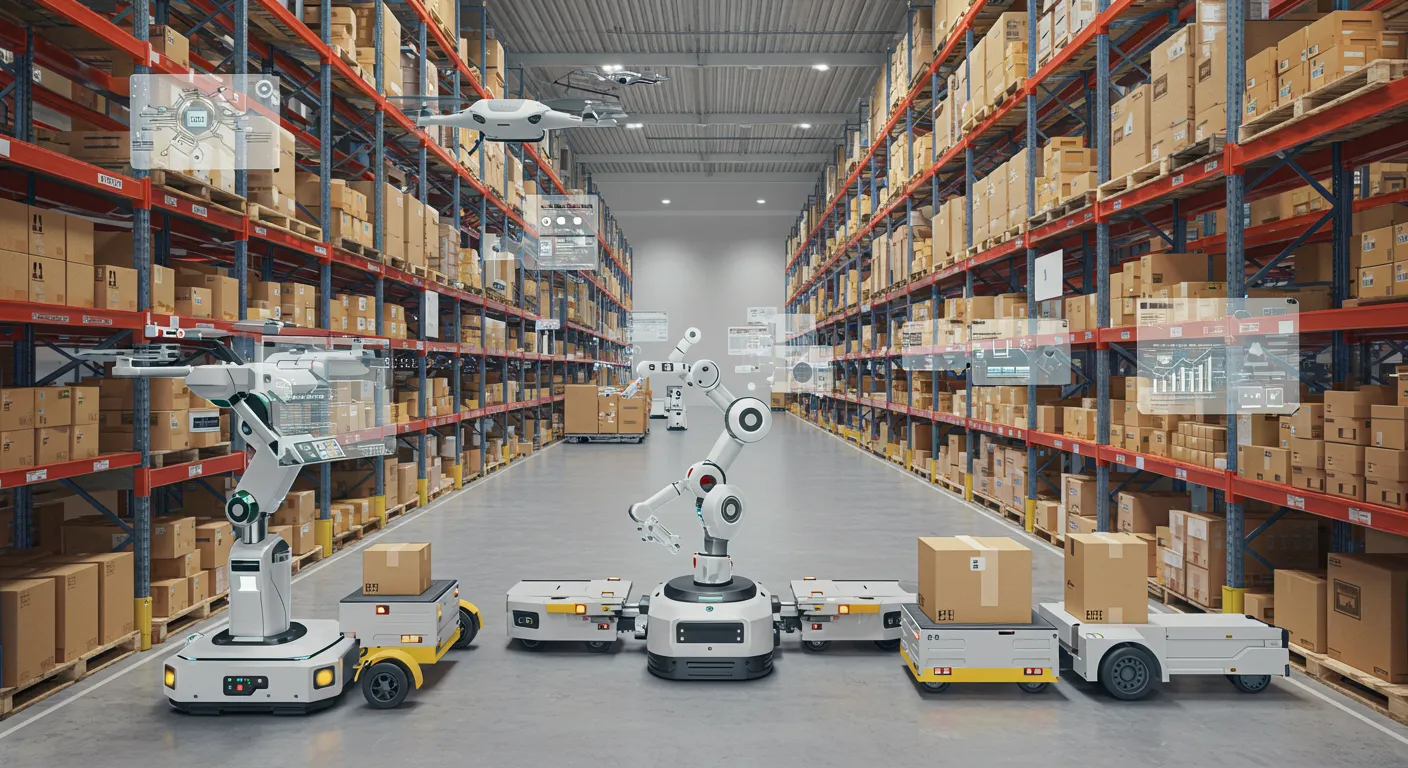Table of Contents
It’s no secret that AI-powered tools have been aiding businesses in recent years, especially when it comes to keeping up with demand while cutting costs. Warehouses, too, gain a lot from working with AI. In particular, the planning and organization aspects of operations flourish when routine task automation makes inventory management more accurate. AI can help you find the right solutions: be it precise words, like this tool, or correct moves for your logistics.
AI’s Role in Warehouse Operations
Warehouses now function as far larger entities than just storage spaces enormous only in size. They’re complex operations that require careful planning and lightning-fast decision-making for smart inventory control. AI-driven warehouse management systems take over tedious tasks, like tracking stock levels or organizing shipments, and predict demand trends. When implemented correctly, the results are faster processes with fewer errors and reduced labor costs.
Automating Tasks for Better Accuracy
AI can handle repetitive warehouse tasks with precision. Robotic picking systems, for example, speed up order fulfillment by selecting and packaging items automatically. Companies using AI-powered robots have seen an increase in productivity and a reduction in labor costs, according to McKinsey. AI-powered robots don’t get tired and make fewer mistakes as a result.
AI-Driven Warehouse Inventory Management
Effective inventory is the difference between warehouse success and complete breakdown. AI in warehouse management takes the guesswork out of stock tracking. AI tools analyze purchasing patterns and forecast demand, reducing overstock and stockouts. According to a report by Gartner, AI-based inventory systems can prevent stockouts, wasted space, and lost revenue.
Smarter Scheduling with AI
An AI schedule maker can optimize warehouse shifts, deliveries, and supply chain operations. By analyzing traffic, supplier lead times, and workforce availability, AI creates efficient work schedules. McKinsey also explored the advantages of AI in operations scheduling, for example, how AI can optimize various operational aspects, potentially leading to reduced downtime.
AI-Powered Robotics are the Future of Warehousing
Robotic picking systems and AI-powered forklifts are transforming storage and logistics. Amazon’s AI-driven warehouses, for example, use robots to move shelves and packages to workers instead of workers walking long distances. Their official blog provides insights into how these technologies have shaped their current operations in recent years.
AI in Logistics to Cut Costs and Reduce Errors
Logistics is where AI truly shines. AI-powered route optimization software calculates the fastest and most cost-effective shipping routes. Companies like DHL use AI logistics systems that have reduced delivery times and cut fuel costs. AI also helps prevent costly mistakes. Machine learning algorithms can spot discrepancies in shipments, flagging potential errors before they become expensive problems. AI-driven quality control can reduce picking and packing errors.
AI vs. Traditional Warehousing
Warehouses that don’t use AI still rely heavily on manual processes, which can be slow, error-prone, and expensive. Inventory management often requires human workers to track stock manually, leading to inaccuracies and delays. Order fulfillment depends on employees physically picking and packing items, which limits speed and increases labor costs. Scheduling is another challenge, as traditional warehouses use static shift plans that don’t adjust based on demand.
In contrast, AI-powered warehouses operate with much greater efficiency. AI-driven inventory management provides real-time stock updates, reducing overstock and shortages. Automated robotic picking speeds up order processing and reduces labor costs. AI-generated schedules adapt dynamically, optimizing worker productivity. AI logistics software improves shipping routes, lowering costs and speeding up deliveries. The difference is clear: AI-powered warehouses are faster, more accurate, and far more cost-effective than those still relying on manual methods.
Real-World Cases of AI in Warehousing
AI isn’t just theory — it’s already delivering results.
- Walmart’s AI inventory tracking: Walmart’s AI-powered inventory system uses machine learning to track stock levels in real time, reducing out-of-stock issues.
- Ocado’s AI warehouses: British online grocer Ocado uses AI and robotics to fulfill complex orders in 5minutes, cutting costs and increasing efficiency.
Are AI Warehouses Actually Smarter and More Efficient?
Short answer: yes. AI is helping warehouses become faster, more reliable, and cost-effective. Automated robots handle picking, AI systems improve scheduling, and predictive analytics optimize inventory. Businesses using AI tools report higher accuracy, lower costs, and better customer satisfaction.
AI-driven warehouse technology trends are only picking up speed. As automation advances, warehouses will continue evolving, making logistics smoother and reducing operational headaches.
The impact of AI in warehousing is just getting started. Future advancements will bring even more sophisticated automation, from fully autonomous warehouses to AI-driven supply chain management. Some experts predict that by 2030, most of the sector will have some form of AI-powered automation.
AI assistants will also play a bigger role, providing real-time insights and helping warehouse managers make better decisions. With AI, warehouses can adapt to demand shifts instantly, improving efficiency at every step.
Should Businesses Invest in AI for Warehousing?
If your business handles storage and logistics, AI is no longer optional — it’s becoming the standard. Companies investing in AI warehouse tools now will stay ahead of the competition, cut costs, and improve overall efficiency.
So, what’s next for your warehouse? Maybe it’s time to ask AI for a little help.


